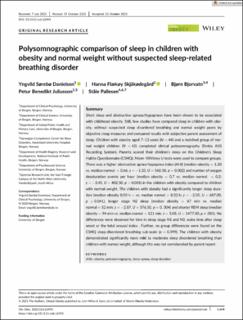| dc.contributor.author | Danielsen, Yngvild Sørebø | |
| dc.contributor.author | Skjåkødegård, Hanna Flækøy | |
| dc.contributor.author | Bjorvatn, Bjørn | |
| dc.contributor.author | Juliusson, Pétur Benedikt | |
| dc.contributor.author | Pallesen, Ståle | |
| dc.date.accessioned | 2022-04-01T11:01:07Z | |
| dc.date.available | 2022-04-01T11:01:07Z | |
| dc.date.created | 2021-11-24T15:58:27Z | |
| dc.date.issued | 2022 | |
| dc.identifier.issn | 1758-8103 | |
| dc.identifier.uri | https://hdl.handle.net/11250/2989233 | |
| dc.description.abstract | Short sleep and obstructive apneas/hypopneas have been shown to be associated with childhood obesity. Still, few studies have compared sleep in children with obesity, without suspected sleep disordered breathing and normal weight peers by objective sleep measures and compared results with subjective parent assessment of sleep. Children with obesity aged 7–13 years (N = 44) and a matched group of normal weight children (N = 42) completed clinical polysomnography (Embla A10 Recording System). Parents scored their children's sleep on the Children's Sleep Habits Questionnaire (CSHQ). Mann–Whitney U tests were used to compare groups. There was a higher obstructive apnea/hypopnea index (AHI) (median obesity = 1.20 vs. median normal = 0.66; z = −1.33, U = 560.50, p = 0.002) and number of oxygen desaturation events per hour (median obesity = 0.7 vs. median normal = 0.2; z = −3.45, U = 402.50, p = 0.001) in the children with obesity compared to children with normal weight. The children with obesity had a significantly longer sleep duration (median obesity 8:50 h = vs. median normal = 8:32 h; z = −2.05, U = 687.00, p = 0.041), longer stage N2 sleep (median obesity = 87 min vs. median normal = 52 min; z = −2.87, U = 576.50, p = 0. 004) and shorter REM sleep (median obesity = 94 min vs. median normal = 121 min; z = 5.05, U = 1477.00, p ≤ .001). No differences were observed for time in sleep stage N1 and N3, wake time after sleep onset or the total arousal index . Further, no group differences were found on the CSHQ sleep-disordered breathing sub-scale (p = 0.399). The children with obesity demonstrated significantly more mild to moderate sleep disordered breathing than children with normal weight, although this was not corroborated by parent report. | en_US |
| dc.language.iso | eng | en_US |
| dc.publisher | Wiley | en_US |
| dc.rights | Navngivelse 4.0 Internasjonal | * |
| dc.rights.uri | http://creativecommons.org/licenses/by/4.0/deed.no | * |
| dc.title | Polysomnographic comparison of sleep in children with obesity and normal weight without suspected sleep-related breathing disorder | en_US |
| dc.type | Journal article | en_US |
| dc.type | Peer reviewed | en_US |
| dc.description.version | publishedVersion | en_US |
| dc.rights.holder | Copyright 2021 The Author(s) | en_US |
| cristin.ispublished | true | |
| cristin.fulltext | original | |
| cristin.qualitycode | 1 | |
| dc.identifier.doi | 10.1111/cob.12493 | |
| dc.identifier.cristin | 1958540 | |
| dc.source.journal | Clinical Obesity | en_US |
| dc.source.pagenumber | e12493 | en_US |
| dc.identifier.citation | Clinical Obesity. 2022, 12 (1), e12493. | en_US |
| dc.source.volume | 12 | en_US |
| dc.source.issue | 1 | en_US |

